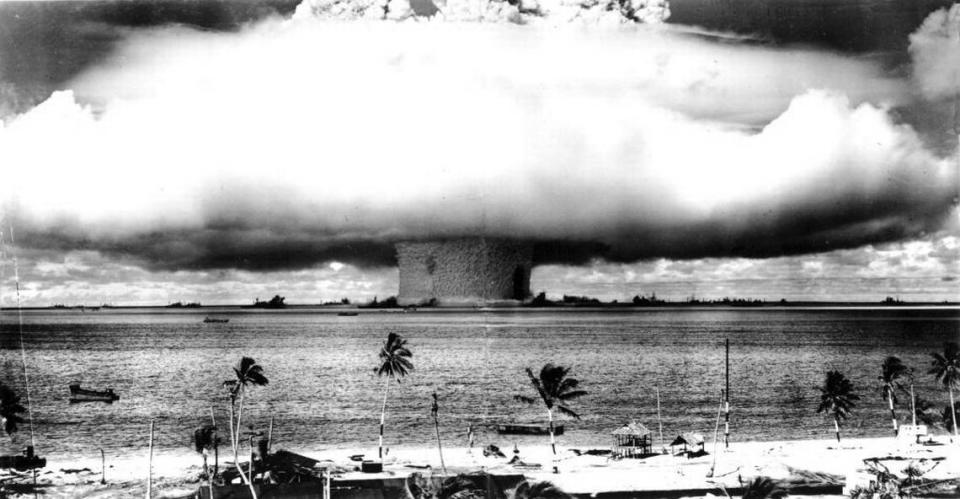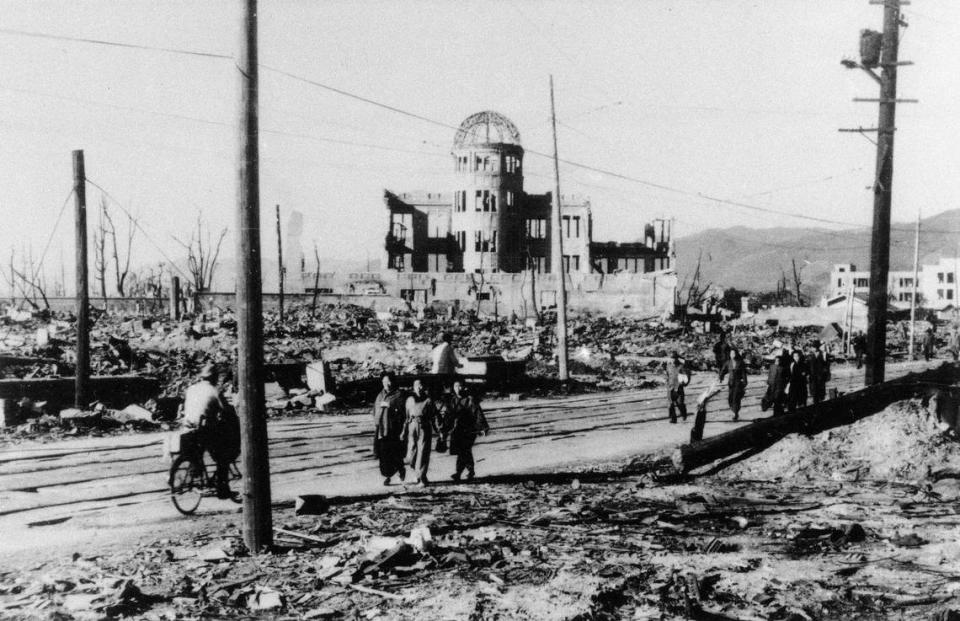‘Must be an A-bomb.’ Atomic test explosions lit up skies above Nevada in 1950s
- Oops!Something went wrong.Please try again later.
“Oppenheimer” opened in movie theaters on Friday.
Helmed by “Interstellar” director Christopher Nolan, the film stars Cillian Murphy as J. Robert Oppenheimer, a theoretical physicist who was pivotal in developing the first nuclear weapons as part of the Manhattan Project during World War II. His work helped usher in the Atomic Age.
After a test blast in the New Mexico desert, the Japanese cities of Hiroshima and Nagasaki were targeted with devastating nuclear attacks that killed thousands of civilians.
Japan surrendered shortly afterward.
Proponents of the bombings argue that they prevented needless deaths, as a land invasion of the Japanese home islands would have cost the Japanese and United States cost thousands of lives. However, that argument didn’t take into account the long-term effects of radiation.
Oppenheimer issued a statement on Aug. 8, 1945, saying there was no reason to believe the bombing of Hiroshima would result in “appreciable radioactivity on the ground.”
Another physicist, Harold Jacobson said there would be deadly results for 70 years.
Those exposed to radioactive fallout reported increased instances of leukemia and other cancers. And their children may also be affected.

Between July 1945 and September 1992, the United States conducted more than 1,000 nuclear tests, including more than 200 atmospheric, underwater and space tests. Then a treaty ended such detonations.
A trip to the Atomic Museum in Las Vegas gives a sense of the scale of effort that went into the testing programs.
In the late 1940s, America conducted a series of post-war tests in the South Pacific. After that of America’s testing returned to the continental United States.
In the 1950s, detonations were on the Nevada desert and flashes from some of the larger atmospheric tests could be seen in the night sky east of San Luis Obispo County — including one noted in the April 15, 1952 Telegram-Tribune.
Even the smaller above-ground tests could be seen on the road to Las Vegas.
Growing concern about radioactive fallout drove testing underground in the early 1960s.
A few decades back, one of my veteran neighbors recalled being assigned to Nevada trenches during nuclear testing. He attributed many of his health complications to the radiation.
On Jan. 27, 1951, the Telegram-Tribune carried a United Press story about tests beginning in Nevada.
First Atomic Test Explosion in Nevada Lights Sky
Game Tables in Las Vegas Ignore Blast
LAS VEGAS, Nev., Jan. 27 (UP) — An atomic test explosion was set off today on Frenchman Flat 100 miles from here and lighted up “the whole western sky.”
The explosion, first in this country in nearly six years, was felt or seen scores of miles to the south and east, but caused only a ripple of excitement in this gambling resort.
Roulette wheels and dice tables, which operate 24 hours a day in Nevada, were still doing a brisk business when the blast went off at around 5 s.m.
In the Golden Nugget, one of the largest downtown casinos, a man standing at one of the crap tables felt the shock. He paused and looked around.
7 Come 11
“Must be an A-bomb,” he said. He turned back to the table and went on with the game.
The atomic energy commission in Washington was the first to announce the explosion. It said it was “One of the periodic tests” of atomic weapons scheduled to be staged at the 5,000-square-mile atomic proving ground in south-western Nevada.
The proving ground is located in a remote, barren area known locally as Frenchman flat. The flat, a 2,000-foot-high plateau, is part of a horseshoe-shaped valley surrounded by 6,000-foot-high mountains.
When the atomic energy commission first disclosed establishment of the proving ground, it told Las Vegas residents they would receive no harmful effects from any atomic explosions set off.
“The people apparently took the commission at its word,” one prominent local citizen said. “You wouldn’t exactly say they were blaze about it today. Its the main topic of conversation, but there isn’t any panic or anything like that.
“Its probably like anything else. The first one will cause a lot of talk, but after while everyone probably will be like the man at the Golden Nugget.”
‘Riders in the Sky’
Las Vegas is more than 100 miles from the central portion of the big atomic proving ground, but many residents here either felt the concussion of the blast, saw the unearthly glow that lighted up the sky or heard the rumbling that followed.
The shock was not observed immediately, however, on seismographs at California Institute of Technology, at Pasadena, Calif. Dr. Beno Gutenberg, director of the seismological laboratory, said it did not show on a “visible” record. But the added that early atom blasts at Alamogordo, N.M. and Bikini did not either.
Residents of southern Utah miles to the east of here said they saw the sky light up and heard the distant rumbling.
Bus driver R.E. White said he was coming toward Las Vegas when he saw it.
“I was about 10 miles below Searchlight, Nev., (some 80 miles south east of Las Vegas) when I saw the blast. It was a funny light off to the west. I felt no shock. I didn’t know what it was but when I reached Las Vegas, I figured it was the A-bomb.”
Another bus driver, John Hornick, was coming in from Los Angeles, when he saw it.
“There wasn’t a thing on the road when suddenly the whole western sky lit up,” he said.
“It scared the dickens out of me. I started looking for a hole to hide in. Then I realized it was an A-bomb and kept right on coming.”
Grace Byrne of Henderson, Nev., said she was wakened when all the window shades in her bedroom rolled up at the same time.
“Then I heard three distinct bombs. The windows rattled and there was a big jar,” she said.
The atomic energy commission announced Jan. 11 that it would be setting off nuclear explosions “from time to time” on the Las Vegas proving ground. Today’s was the first. A “dry-run, non-nuclear” detonation was set off Jan. 24 to test instruments.
The Las Vegas atomic tests are the first held in this country since July 16, 1945, when history’s first experimental A-bomb explosion was staged in the New Mexican desert near Alamogordo.
Since then, seven other U.S. A-bombs have been exploded. Two were used in World War II against Japan.


